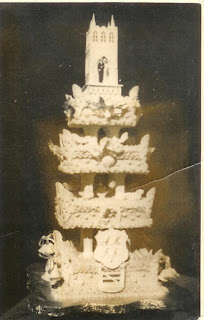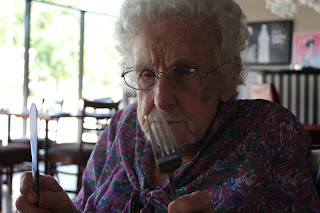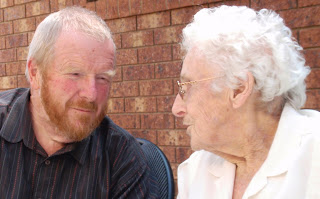I can’t remember ever having typed out a
speech/talk/lecture/presentation in full but I did with this one in case I lost
it and my wife had to take over. I printed it in 16 pt too so I could read it
without my look-overs, just in case. Even though the second last page vanished
into a black hole while I read I winged it and read the “thank you” paras –
carefully written to make sure I didn’t leave out anyone I was truly grateful
to. So I got to the end. Easy!
But then I chucked in a last sentence. What
an idiot. I turned to the coffin and started to say, ‘Bye Mum; it’s been fun.’
I got as far as, ‘Bye.’ and whispered
the last four words totally blinded with tears. I stared at the lectern. At least
I could see the step down to the floor and my seat.
It’s difficult to point to Mum’s achievements
because, mostly, they’re not tangible. There are no university degrees, no
college diplomas, no certificates of appreciation, no robes of office, no military
medals, no community awards, no sporting trophies on her coffin today. Instead,
the high achievements of hers relate to the effects she had on our individual
lives.
On the day a girl was born in rural Victoria in
February 1916 The Argus was filled with articles about the war – the Great War
– in Belgium. Our knowledge of the history of the next 40 years or so –
principally two world wars and the great depression – suggests that any chance
of happiness and fulfilment for the child would have been very small.
The influence of these large-scale catastrophes was
ever-present in Mum’s life even though, in her case, she apparently didn’t
think their effect was out of the ordinary. And we, her kids, in some ways were
the mirror image of her growing up. We had very little disposable cash but we
had good food. The family income was small but it was enough to clothe us. Mum
sewed, knitted, mended, darned; she never threw away; she used till it was
threadbare – transparent. She only used a new tea-towel, a new bath towel, when
I took the more-holes-than-thread models away and binned them.
She grew up in a country town. Her father had the
Malvern Star bike agency in Wang opposite the Boar’s Head. He repaired
gramophones and serviced guns. The family had a small income but their food
supply was supplemented by fish from the river and rabbits from the foothills
of the Warbies. Mum told us about buying a lump of dough from the bakers on the
walk home from ‘down the street’ on Friday night – a weekly social occasion –
frying it and sprinkling it with sugar to make puftaloons. White flour, white
sugar and fat. Yum!
JEGM - the source of all the ginger genes at the
funeral
|
And, not
surprisingly, that was the nutrition we were fed as kids. Plenty of meat, veg – all very well roasted or boiled. She sometimes made my favourite: steamed golden syrup dumplings made
with honey rather than golden syrup: white flour, honey and fat. Yum!
My point is that what she provided for us was, in
many ways, a reflection of her own childhood. She cooked family staples of
scones, sponges, roast lamb, vegetable soup without tomato in it because Nanna
put tomato in hers. She made grapefruit marmalade, apricot jam, tomato sauce
and she bottled fruit as she had done for her father and her siblings for seven
years after her mother died. When the fridge replaced her coolgardie safe (a
big event) she made ice-cream for us. She cooked on a wood stove just as her
mother had done for most of her life. But when the washing machine replaced
Mum’s copper she still had to iron in the kitchen on a 100 degree day with the
wood stove alight to drive the hot water system.
It’s clear that, in what little education she did
get, she never shone. In this there are the beginnings of how she saw herself.
The typical school Geography/History/Science curriculum of the early 1930s
depended heavily on memory: rivers, countries, cities, seas but her memory for
unnecessary facts was hopeless (as is mine). She would have done badly on
memory-based tests (as I did). As well, girls were taught domestic science (the
correct order for washing up and how to make sandwiches) and needlework: useful
stuff for serving girls. Domestic skills; Home duties.
She had piano
lessons from a bloke over the road in Moore Street but she failed. She told us,
“I was pretty dull”. Having no piano to practice on may have been a contributing factor,
Mother! Dull had nothing to do with it because she had an intuitive understanding
of music. She hated (her words) “screeching sopranos or tinny electronic
organs”. This idea – that she was intellectually dull – re-appears throughout
her life, but it’s nonsense.
She read a lot (she loved books; strangely for a
dullard!) she listened to ABC country radio, 2CR, with its river heights and Blue Hills and, once in a while, got some
classical music on the wireless. Once a year a concert might hit St Pat’s Hall.
Vladimir Ashkenazy, for example, played Beethoven and got a bit lost in one
movement of the Moonlight but nobody seemed terribly perturbed. Apart from the
annual Choral Society G and S there wasn’t much else.
About a year ago I’d finally had enough of having
to buy that terrible excuse for decent journalism, that right wing Murdoch rag, The Herald Sun. I suggested The Age; it had crosswords like the Sun. “I’m not
intellectual enough”, she said.
Right!
So I think the idea that originated in her
childhood and was never challenged or changed. She left school at the end of
Second Form and went to work in the mill. Her mother died when she was 17 and
the family conference resulted in her leaving work to run the house and bring
up her baby brother, Jack.
Her mother had left the Church of England (where
Mum had gone to Sunday School) down the slope to the Church of Christ. Mum
followed.
She met her husband at the church. No other meeting
place was possible for Churches of Christ young people because that would have
meant socialising and marrying outside the clan. Her social life was within the
church; tennis was big. There was a court in Baker Street behind the original
church building where she, in turn, tried to teach me. I hit the ball over the
fence (at least I hit it!) into the long grass of what is now Safeway’s
carpark. We went home. Again, she’d failed.
They were married
in 1940. No bridal dress: no money. A blue (wool fabric? it was August) dress and
a maroon handbag. The wedding breakfast was supplied by her friends and her
family at her sister Edna and Les Montgomery’s café near her dad’s bike shop in
Murphy Street. Her brother-in-law Les made the wedding cake – a four-story
monster with a plaster steeple on top. Magnificent! The whole affair was done
on the smell of an oily rag in wartime when everything was hard to get. Not yet
rationed in 1940, but hard to get.
 |
| Les Monty’s creation |
Even if she
assumed the servant role – appropriate for a dull girl that doesn’t mean she
wasn’t loved and respected because, during our childhood; she clearly was. And
after her marriage, you could argue, she was trapped in the shadow of a
husband, his work, his church and his mother’s family.
 |
| 10 August 1940 |
She became wife of
a career beekeeper who was ever at the mercy of the weather. What he did on a
given day and therefore what she did was often decided a bit after dawn and she
had no say in it. The basics of ‘home duties’ were fundamental. Those activities
that could be done without much intellectual input: pack the tucker box for
Dad, shopping, cooking, cleaning, washing, ironing, managing kids with a
husband who was away for days at a time in Summer and working on maintenance
and beeswax production in Winter. She didn’t grow vegies; that was Dad’s job.
Throughout our childhood, Mum had church: Ladies
Guild and Women’s Christian Temperance Union – I was a little White Ribboner (I
had the pledge certificate, ‘Lips that touch liquor shall never touch mine’).
And Dad was church secretary for ever: it was the Jackels' church – started in
Dad’s parents house and Dad’s mother was its social organiser – and Mum had no
option but to support that.
Nanna, by the way, would have been aghast at Mum
taking up boozing at her 90th birthday party. She (Mum, never Nanna) developed
a taste for, appropriately, working class champagne, ie prosecco, which she
socked away as if it were lemonade.
Mum lived next door to Dad’s oldest brother Lloyd
and next to them lived her mother-in-law; all with interconnecting side gates
and open back doors. Nanna, her mother-in-law whom Mum referred to universally
as Granny, was the matriarch.
So Mum’s environment all through our growing up was
no job, no independent money, a matriarch two houses away, bees that had to be worked, and
the church that had to be run – all of
which was ever-present. Mum was an intelligent woman – even if she was led to
believe she wasn’t. She was fundamentally independent – as St John’s care staff
constantly commented – right into her 100th year.
And determined in her own quiet way. Another
characteristic St John’s staff constantly commented on. Determination that, in
her last years, led to frustration at not being able to move as she always had.
And that, in turn, led to her falling when staff did not show up fast enough to
get her off the toilet and back to her chair in front of the window (or in
front of the telly to watch Question Time; you’re cracking up Mother!)
So it’s no wonder that, when we were kids,
frustrations occasionally boiled over. Conflict resolution skills? Never heard
of it. But they loved each other even if they only showed it occasionally.
Public – and private – displays of affection were almost unheard of.
So she was, or became stoic, and made the best of
her life. I sat beside her through Dad’s funeral service where she remained
dry-eyed and in control. But photos of her all through her life show a
bright-eyed, smiling, happy woman.
All the evidence I’ve found pointed to her being a
happy child growing up in a happy family with not much but more than enough. I
got the picture of a simple life-style with simple pleasures. She hated me
organising the cook’s dishes after the meal was served. I now know that was
because she liked her tucker hot. She ate it quickly. On the bass of no
evidence at all I think that was due to living in a big family that included
three boys. “Don’t you want that chop? I’ll have it, ta.” So she got stuck into
her tucker with single minded determination. There was no point trying to have
a conversation – polite or otherwise – with Mum when she was eating.
 |
| Lunch is late! |
Let me go back to
the dull idea.
Verbally dull she was not.
Mum was a smart mouth (I’m being polite because I
can’t say “smart arse” here in the Cathedral). She had a smart, quick wit.
Here’s a picture. About five years ago at the
kitchen table for her ACAS assessment, the nurse is asking questions and
completing a form.
Nurse, “How do you keep track of your appointments
– chiropodist, doctor etc”
“I write them on the calendar.”
Nurse, “This one here behind the kitchen door?”
“Yes.”
Nurse, triumphant at having caught her out, “But
how do you know which day it is?”
“I look at the paper.”
Silence.
And again, at lunch earlier this year;
Me, “Would you like some water, dear”
Quick as a flash, “Only if it’s got tea in it.”
And one more;
At lunch in the King River Caf a couple of years
ago.
The pot of tea arrived. She turned the teapot
handle towards me.
“Pour, slave.”
“Yes Mother.”
All this from a woman whose chief hobby was not
answering the question. I sat with her at the eye doctor for her cataract
operation review. She gave not one of his questions a straight answer – and
this with a straight face. In a different era she would have done an arts
degree in order to drive a tram or work in a library. Instead she raised two
kids, six grandkids and a dozen or so great grandkids. She couldn’t disown us
even if she wanted to because many of us have her family’s red hair. The genes
are easily traced back to her father James Edgar Gordon Moore (what a great
name) then to a whole tribe through Wendy and me. The red genes also by the way
found their way into her sister Edna’s line and at least one other line that
turned up 30 or 40 years ago. JEG Moore was evidently an enthusiastic
procreator. Gingernuts of the world unite, Mother! There are 26 of your direct
line here today. We are all down to you.
She wrote to me on
23rd April this
year on mauve paper in a mauve envelope. Not many people get hand-written
letters from a 99 year old woman, “I thought to surprise
you.”
Stirrer!
“You seem to be having a very busy time, a very rewarding one. I was
telling Judy how lucky I was to have this room. I have just seen a gaggle of
about seven wild ducks waddle past. It must be duck opening day.”
 |
| Me n my mum |
Thank you Rev
Goodyer, The Dean, for allowing us to use the superb Holy Trinity Cathedral and
for your flexibility in writing the service.
Thank you John
Scott for the magnificent music. I pointed out earlier that one of Mum’s
one-liners concerned “screeching sopranos and tinny electronic organs” A year
or so ago she and I conspired to hear this wonderful Willis/Lewis beast today. http://www.ohta.org.au/confs/Albury/WangWillis.html
It has a 32 foot pedal stop – a big bugger – and an 8 ft Trumpet
on the Great that John rarely has an excuse to use. I’m glad he can use it today.
 |
| A big bugger indeed. Image © by lfb |
Festive Trumpet Tune, David German, b 1954
Thank you, nursing
staff at St John’s Village for you excellent care since Mum has been a resident
with you. Especially, I thank the RNs who were on duty over the last week of
Mum’s time there. Their palliative care system included us, her family and involved
– I discovered – cuddle-based pastoral care when the RN concerned decided you
needed it.
But most of all,
thank you Judy, Ann and Rob and Masie who were the people on the spot for Mum
in Wangaratta with her family in Melbourne. You were critical people for Mum.
She respected you, she loved you and she depended on you.
I’d barely parked my bum on the end of the
front pew where chief mourners sit when a small gingernut grabbed my leg and
rested her head on my knee. Apparently she’d asked her dad, ‘Why is Granda
crying?’ When Andrew told her she decided I needed a hug. In typical Miss Lil
fashion she’d decided problem required solution – no debate required – so she
scuttled around the front pew to provide it.
Thanks Lil. I won’t forget that.



















